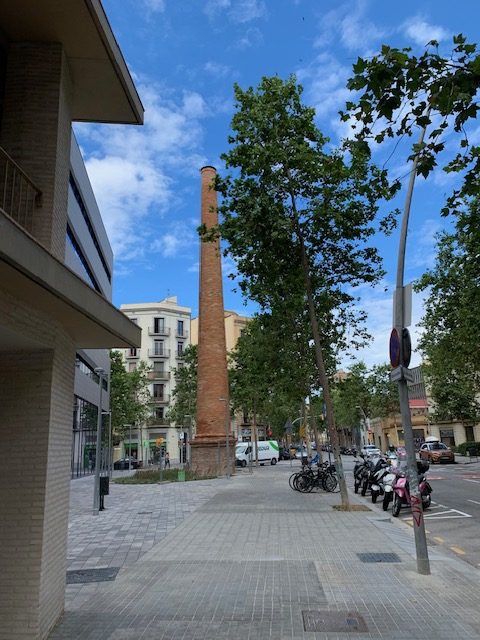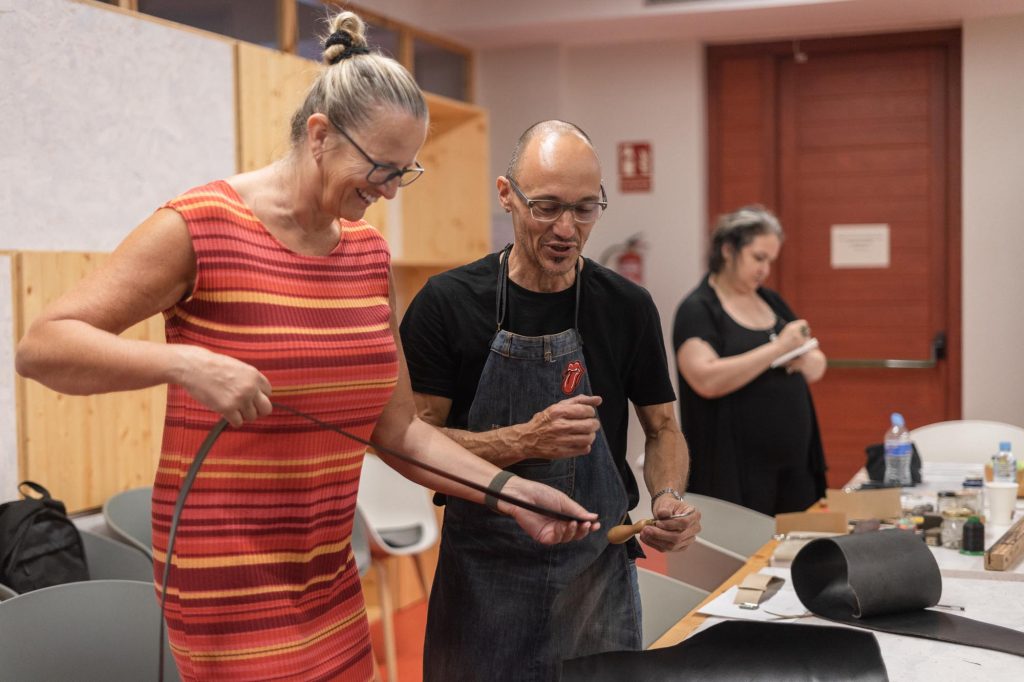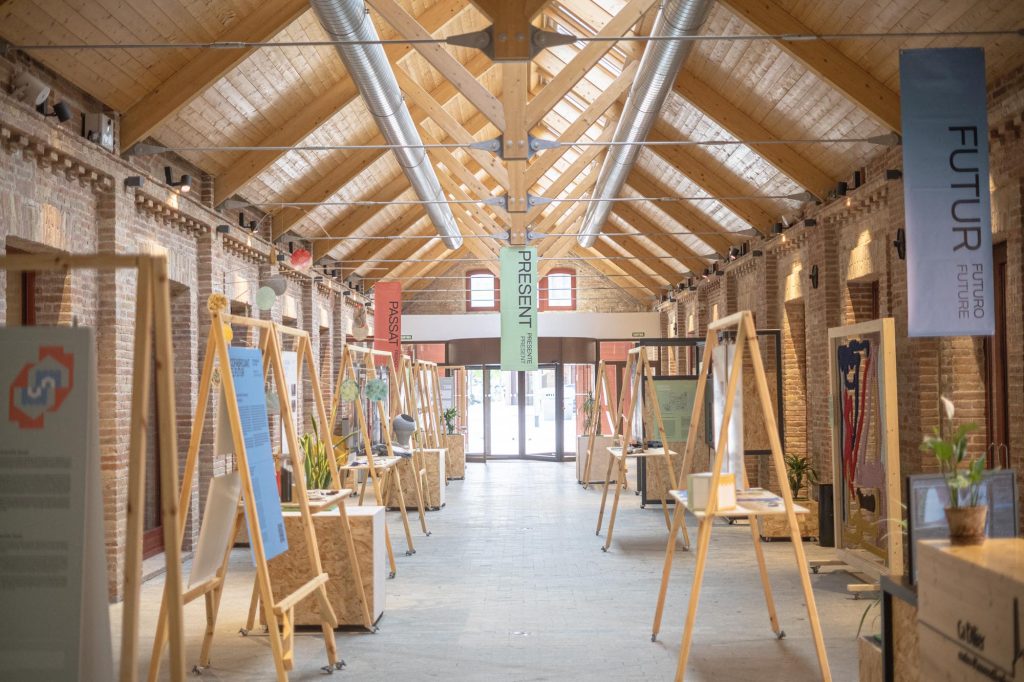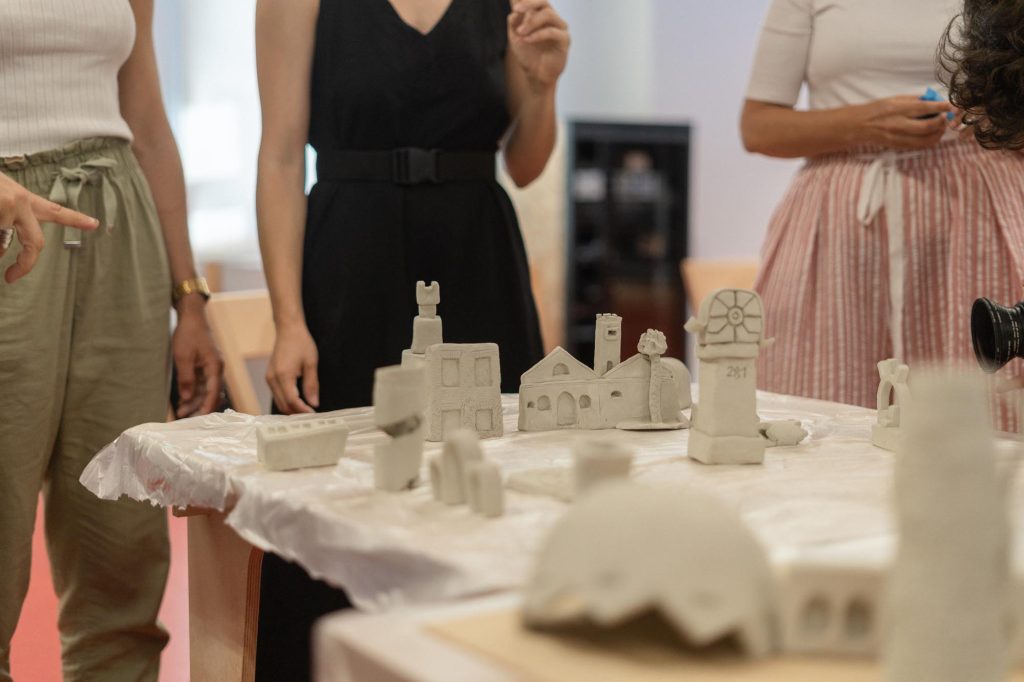BLOG
It’s about people and heritage
It’s about people and heritage
It’s about people and heritage
Visiting the Poblenou Fàbrica/ Fabrica Exhibition by the Barcelona pilot
Marjan Otter
CENTRINNO (New CENTRalities in INdustrial areas as engines for inNOvation and urban transformation) is now in its final year. Nine cities have designed new methods and conducted investigations over the past four years on how to develop a Fab City Hub (FCH).
In Barcelona, one of those nine cities, Fab Lab Barcelona at IAAC (Institute for advanced architecture of Catalonia) organized several meetings and a beautiful exhibition between May and June 2023 to conclude this project. For this blog I spoke with Guillem Campodron Pujol, the executive director of Fab Lab Barcelona, and Milena Calvo Juarez, an environmental engineer and sustainability researcher in the same research and innovation center .
I participated in the last of a series of workshops, this one by Fabio Zalla, a local craftsman specializing in leatherwork. I also attended the closing event with all partners and individuals involved in the CENTRINNO project. Additionally, I witnessed the presentations of the students from the Master in Design for Emergent Futures (MDEF) program and the students who participated in the Barcelona CENTRINNO School Hackathon, which provided vocational training outside the classroom.
The rapidly changing industrial neighborhood of Poblenou
Poblenou in June is a wonderful place to be. It’s sunny but the old trees provide plenty of shade and there are many new green areas that give the entire neighborhood a modern and friendly atmosphere. Some vegetable spaces were so new that the red and white barrier tapes were still present to protect the vulnerable plants.
This mix of old and new is visible throughout Poblenou, a neighborhood of the emblematic Sant Martí District. Some very old and dilapidated architecture awaits demolition, while beautifully preserved structures lend character to the streets and corners. There are new spaces already in use and hypermodern buildings still under construction.
The barrio (neighborhood) Poblenou is a lively part of Barcelona with traditional industries, sometimes noisy and smelly, along with creative industries and hipsters in coffee bars. It is home to traditional small entrepreneurs, craftsmen, supermarkets, bars and restaurants – a combination that sometimes causes friction and evokes both nostalgia and excitement for the future.
Fab Lab Barcelona
Fab Lab Barcelona is located in the heart of the Poblenou neighborhood, where the CENTRINNO Barcelona pilot focusses on. As coordinator of the local CENTRINNO pilot, the Fab Lab Barcelona team led the participatory development of the exhibition, in collaboration with numerous local actors, including the pilot project partners Poblenou Urban District and the Educational Department of Catalonia (Catalunya FP). The “laboratory exhibition”, is one of the initiatives coordinated by the organization, known for its significant legacy in the territory due to previous projects, educational programs and research carried out, but also for its effort to showcase Poblenou as a Productive Neighborhood.

Poblenou neighbourhood. Photo credits: Marjan Otter
Regarding the heritage aspects and historical facts of the ‘barrio Poblenou’, Fab Lab Barcelona counted with the expertise and curation of Salvador Clarós i Ferret, the representative of Industrial Policy in the Comisiones Obreras (CCOO) de Cataluña (Workers’ Commissions of Catalonia) and also who led the presidency of the Poblenou Neighborhood Association for many years during the intense territorial transformation. Fab Lab Barcelona also had the support of the Arxiu Históric del Poblenou (Historical Archive of Poblenou) with valuable heritage images and historical records since the neighborhood stood as a leading center of the European textile industry.
Salvador has conducted research into how sources of production (of cars, textiles, and so on) has been moving out of the city. His knowledge of the development of this barrio since the beginning of the industrial revolution is reflected in the first part of the exhibition that was created to share the results of the CENTRINNO project with the public.
The organizing committee, including Milena, Julia, Audrey and Guillem and others, is highly enthusiastic about the project and has various connections with the Poblenou neighborhood: its inhabitants, the old and new craftspeople in and around this barrio, the old industrial buildings and the new initiatives that make Poblenou a nice blend of historic and modern. Their ability and eagerness to connect are evident in the output of the Barcelona CENTRINNO pilot: in the exhibition, in the final meeting, in the workshops with local craftspeople and in the presentations of the students, both from the vocational training activities as well the Master in Design for Emergent Futures program.
The venue
All activities during the final week of the CENTRINNO project took place at Ca l’Alier, which is described as “the fabric of the past where they are constructing the city of the future”. It is an old textile factory that has been renovated while the feeling and memory of its former industrial history is still maintained. As the current Urban Innovation Centre of Barcelona and headquarters of the municipal Foundation BIT Habitat, the building is now open and inviting, with two entrances, state-of-the-art facilities and activity rooms. There is still a huge chimney that is no longer in use and therefore meticulously clean and a part of the building that is decaying and overgrown with plants, resembling something like an industrial version of Sleeping Beauty’s castle.

Ca L’Alier. Photo credits: Marjan Otter
A series of workshops on arts and crafts in Poblenou
The focus of the CENTRINNO project in Barcelona is craftsmanship. How can traditional craftsmanship, rooted in this neighborhood, inspire creativity in this barrio? How can the skills, knowledge and qualities of these craftsmen be preserved and valued by the new inhabitants? And how can these skills and creative approaches be relevant to the issues of modern life (like climate change)?
In a series of four workshops led by local craftspeople, interested residents of Poblenou or Barcelona and members of Make Works Catalonia, were invited to get acquainted with their skills and make a product that can be found in those local tallers (workplaces).The workshops covered woodcarving, ceramics and visible mending, and the last one, conducted by Fabio Zalla, artesano de cuero y piel (craftsman in leather and fur), was about leatherwork. Fabio Zalla’s taller is only four blocks from Ca l’ Alier, the venue of the workshop.
Six participants joined this final workshop, half of whom lived nearby or in Poblenou. Interestingly, half of them (but not the same half) were non-native Spanish speakers so the workshop language shifted to English to accommodate everyone. The workshop’s purpose was to make a leather belt.

Fourth workshop on leather by Fabio Zalla. Photo credits: Fab Lab Barcelona
Although six participants may not seem like many, it took considerable time to guide each of us through the many steps involved in crafting a beautiful belt. Fabio took us by the hand and showed us all aspects of the craft including the love for quality materials such as leather, buckles, and nails. We also learned to appreciate the practical tools we didn’t know how to use at first and understand the value of the hours of work required to make something by hand. All participants were proud of their results and one of them beautifully expressed:
From now on, I will never look at a belt the same way. Now I understand the amount of work and love that can go into a handmade belt. I will wear mine with pride!
This clearly showed that the impact of this workshop – in combination with Milena’s introduction, and the exhibition in which Fabio was represented – is a change of behavior and actions of the participants. I’m sure some of the participants will find their way to his taller in the future.
The exhibition also had in its initial development phase, between March and May, ten participatory workshops in which citizens were invited to discover traditional techniques of woodworking, biomaterials and cross-stitch embroidery while supporting the exhibition design and set up.
Still with the goal of exchanging knowledge, fostering collaboration and empowering citizens to “make almost anything” (fab labs tagline), seven workshops about digital fabrication were carried in a distributed format across six districts of Barcelona. This collaboration was consolidated with the Xarxa d’Ateneus de Fabricació (Network of Public Fab Labs) of Barcelona exploring techniques such as laser cutting, CNC milling, ceramic 3d printing, biomaterials and digital embroidery.
The exhibition Fabrica: presentation to the public
The CENTRINNO project exhibition, called Poblenou Fabrica/ Fàbrica, l’arxiu viu del barri, consisted of three elements representing the past, present, and the future. The texts were written and curated mostly by Fab Lab Barcelona, and some pieces in collaboration with CENTRINNO Barcelona pilot partners and heritage experts from the Reinwardt Academy.

The laboratory-exhibition divided in Past, Present, Future. Photo credits: Fab Lab Barcelona
The wooden structures that were used to display photo and text panels deserve recognition. It was handmade, combining traditional carpentry with digital fabrication, by Fab Lab Barcelona in collaboration with residents of Poblenou, using leftover wood from the Mobile World Congress, one of the biggest conference events of Barcelona City. The construction is simple, yet effective and versatile. It is lightweight, easy to move and store and serves as an excellent example of how craftsmanship truly inspires the people involved in the CENTRINNO project. The structure can also be reused multiple times: It was used for the Circular Cities Challenge Exhibition at the CosmoCaixa Venue and will be replicated for the Future Faire of Fixing the Future event in October at the Barcelona Design Hub.
A wonderful example and proof of circularity as promoted in this CENTRINNO project.

The wooden structures and photos of the local artisans. Photo credits: Fab Lab Barcelona
Ca l’Alier is a lively place but not crowded with visitors. Visitors are free to walk in, and by doing so they were confronted with the CENTRINNO exhibition mounted in the central hall from May 5th until June 15th. The introduction panel stimulated visitors to identify themselves, involving them by stating that their visit made them part of the Poblenou Fàbrica/ Fabrica community. There were more visitors than local residents from Poblenou. Most of them were students or individuals working in the public sector. Some were artists and among those who came from the neighborhood, most were retirees.
The Local Living Archive
The “Mapa Emocional del Poblenou” (Emotional Map of Poblenou) was presented through a touchscreen displaying a map of the neighborhood marked with dots. The description on the touchscreen read: “Discover the Emotion Networking of Poblenou by the Cultural Association Els Fumats”. It was a written sound and visual archive that compiled the memories of the local community, a different opportunity to learn about the connection between people and territory. This association, founded in 2016, aims to build and strengthen the social fabric of the neighborhood, promote the inclusion of minorities and fight against gentrification through the use of popular culture and art.

Local Living Archive. Photo credits: Fab Lab Barcelona
The memories that have been shared in this map “make us value the fortune of having been able to listen to such endearing stories of Poblenou that was, and that now belongs to the memory, a memory that we want to never die because it is shared, and that we believe is essential for the construction of a united, popular and supportive neighborhood.” Els Fumats)
There were stories of families, of friendship, of love, of places that have disappeared, of things that happened and happen in the neighborhood.
Every city participating in CENTRINNO focuses on a heritage dimension of its own. In Barcelona the focus was on the makership of today. The stories, which popped up when people touched the screen, showed the value local creative makers and craftsmen give to Poblenou, the barrio in which they work and/or live.
In addition to the local living archive in Barcelona, CENTRINNO recently released a platform where the stories of different cities are being shared, you can explore them in the CENTRINNO online Living Archive here.
The exhibition was divided into three sections, which are delineated and described below:
1 The past – Poblenou Factory Land
“This exhibition uncovers the layers of Poblenou’s past. Beyond the grand narratives of the past this project aims to uncover the forgotten stories and lived realities in and by the neighborhood, this can help to understand what heritage means today.”
The history of several industrial objects was presented on individual timelines. Those timelines made painfully clear that it took years of action and rebellion of concerned and involved citizens to safeguard these important and iconic buildings. It was illustrative that the venue of the exhibition was one of those industrial objects. This showed the results and proved the value of their actions.
2 The present – The Maker Community
“Poblenou emerges today with a renewed, productive identity that is, at the same time, influenced by its recent past. … The people behind this shift fabricate their own stories: they put value on the past as a source of knowledge to innovate in sectors such as contemporary handicrafts.” Eleven of those craftspeople (male and female) were presented with their special working tools and products as “The maker community”. Some of them were also involved in the workshops. This combination of photos of the artisans, the presentation of their tools and materials, and the possibility to participate in skill-sharing workshops, gave visitors of the exhibition the opportunity to meet those craftspeople in person, and to learn their skills from first-hand.
3.The future – Making the future together
This section provided more information about some educational projects led by Fab Lab Barcelona, showcasing some of the results and the methodologies used, and highlighting the Barcelona CENTRINNO School programmes supported by several local organizations.
The two editions of the CENTRINNO School Hackathon involved more than 60 vocational training schools and approximately 1150 students in Catalunya).
One notable feature was the introduction of the Barcelona CENTRINNO Hackathon cube: a design thinking tool that inspired and supported participants during their creative process of “making the future together”. `
The methodology comprised six key stages:
1 &2 Analyzing and understanding the context of the challenge,
3 Stimulating and prioritizing ideas,
4 Seeking references
5 Planning the development.
6 Communicating ideas.
Student Presentations
The exhibition gave space for students to present their creative interventions focusing on making more resilient futures. It happened in two consecutive sections. Approximately 30 vocational students presented the results of their projects connected to the CENTRINNO School Hackathon, a program co-developed by Catalunya FP and Fab Lab Barcelona. Ranging from a collaborative aquaponic system to the production of signages made from recycled plastic to boost the neighborhood’s creative sector, the VT students had the opportunity to share their achievements and get final feedback from the participants’ local organizations.
The other round of presentation was done by the MDEF students, a master program by Fab Lab Barcelona and Elisava School of Design and Engineering.The students from the Master in Design for Emergent Futureschallenged the status quo and designed for the problems of tomorrow.. Their ideas were transformed into workshops, exhibitions, presentations, discussions, events, walking tours and even a collective tarot reading. These projects or interventions were intended to be part of the NO(-)BODY KNOWS festival and aimed to amplify the impact of maker practices. The projects ranged from biofeedback devices for empowering athletes to “a cocktail with the sea performance” and an indigo dyeing workshop for repurposing and upcycling fashion.
Final meeting / closing event with all partners and participants
The meeting started with a thought provoking and inspiring energizer activity.
At the beginning of the CENTRINNO project, several years ago, participants were invited to create a “space for the future” using clay. Those sometimes-beautiful objects were preserved and now displayed on the table. Since circularity is an important theme of the project and not everything is worth preserving, participants were invited to express which objects they valued and which ones they valued less along with their reasons. The objects considered less valuable were then placed in a tub of water to dissolve and become clay again. This act symbolized both destruction and the creation of conditions for a new beginning. Throughout this selection process, the efforts invested by individuals in creating their objects were fully acknowledged. This energizer activity highlighted the challenges of selection, emphasizing the need to make choices and visualizing that destruction can lead to construction.

Clay workshop at the closing event. Photo credits: Fab Lab Barcelona
The goal of this meeting was to stimulate all partners to establish a robust network as the CENTRINNO project concludes. How can a community of creative spaces be consolidated? The participants (26 persons) agreed that “the benefit to the community must be greater than the individual objectives”. Therefore, it is crucial to continuously assess the impact of all actions and community members should consider the implications of everything they do. Only by keeping this in mind can social impact be achieved and real change be accomplished.

Final roundtable at the closing event. Photo credits: Fab Lab Barcelona































































































